Banco Bradesco Bundle
Who Really Controls Banco Bradesco?
Unraveling the Banco Bradesco SWOT Analysis is just the beginning; understanding who owns Bradesco is key to grasping its financial strategy and future direction. From its humble beginnings in 1943 to its current status as a financial powerhouse, the evolution of Bradesco's ownership tells a compelling story. This exploration dives into the ownership structure of one of Latin America's largest banks, revealing the forces that shape its decisions and drive its growth.
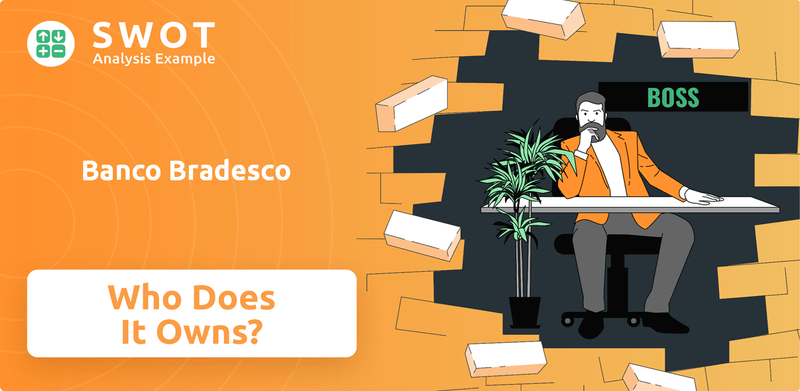
Understanding the Bradesco owner and the dynamics of its shareholders is essential for investors and analysts alike. As a publicly traded company, the Bradesco stock performance is closely linked to the confidence of its investors. This analysis will examine the Bradesco parent company, major shareholders, and the historical shifts in its ownership, providing a comprehensive view of who controls Banco Bradesco and how that influences its operations.
Who Founded Banco Bradesco?
The story of Banco Bradesco begins with its founder, Amador Aguiar, who established the bank on March 10, 1943, originally named Banco Brasileiro de Descontos S.A. Aguiar's vision was to create a financial institution accessible to a wider segment of the population, focusing on small landowners, retailers, and government employees.
The early ownership of Banco Bradesco was rooted in community-based deposits rather than large initial investments. This approach was central to Aguiar's goal of fostering financial inclusion. The bank's evolution, from its humble beginnings in Marília, São Paulo, to becoming a major player in the Brazilian financial sector, reflects this initial focus.
The bank's headquarters moved to São Paulo in 1946, and by 1951, it had become the largest private bank in Brazil by sight deposits. The establishment of Fundação Bradesco in 1956, by Amador Aguiar, was a crucial step in the ownership structure, ensuring alignment with long-term objectives.
Banco Bradesco was founded on March 10, 1943, by Amador Aguiar.
The bank initially targeted small landowners, retailers, and government employees.
The headquarters moved to São Paulo in 1946 and to Cidade de Deus in 1953.
Fundação Bradesco was created in 1956 by Amador Aguiar.
Fundação Bradesco holds primary voting control over the bank.
The goal was to ensure alignment with long-term objectives and social development.
Understanding the Banco Bradesco ownership structure is key to grasping its long-term vision. The bank's ownership is primarily influenced by Fundação Bradesco, which ensures that the institution remains committed to its founding principles. The Bradesco owner structure reflects a focus on community and social responsibility, which has been maintained since its founding. If you want to know more about the Bradesco shareholders, you can find information in the bank's annual reports. For those interested in investing, it's important to understand the Bradesco stock performance and how it relates to the overall market. To understand the Bradesco parent company, you should look at the role of Fundação Bradesco. For a deeper dive, consider exploring the Target Market of Banco Bradesco.
- Who owns Bradesco: Primarily Fundação Bradesco.
- Bradesco's ultimate beneficial owner: Fundação Bradesco.
- Is Bradesco a public company: Yes, but with significant control by Fundação Bradesco.
- How to find Bradesco's owners: Information available in the bank's annual reports and regulatory filings.
Banco Bradesco SWOT Analysis
- Complete SWOT Breakdown
- Fully Customizable
- Editable in Excel & Word
- Professional Formatting
- Investor-Ready Format
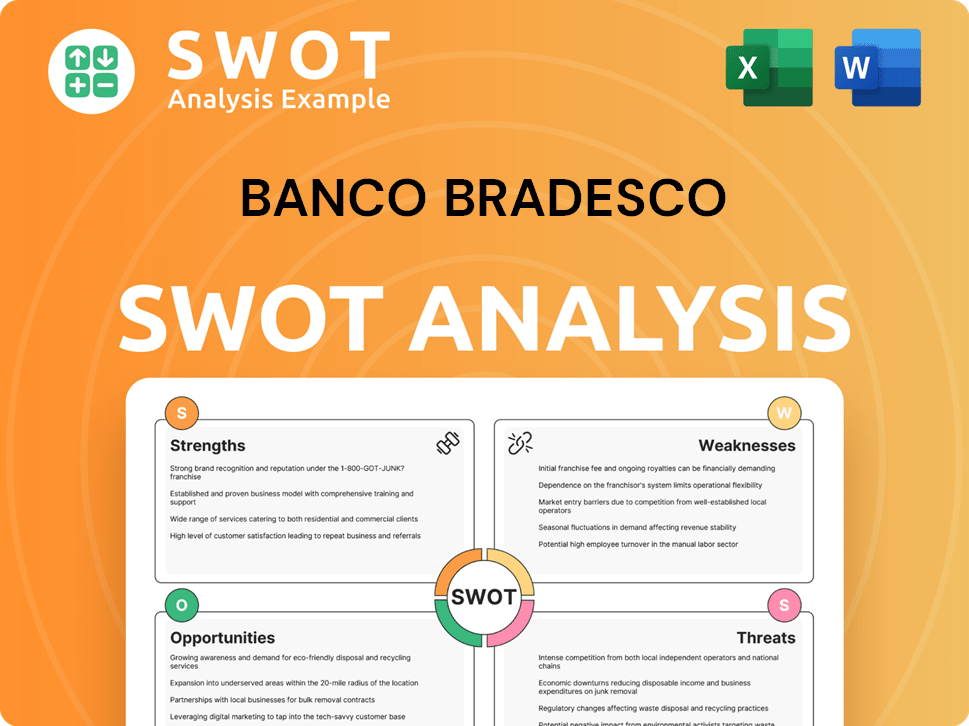
How Has Banco Bradesco’s Ownership Changed Over Time?
The ownership structure of Banco Bradesco has evolved significantly since its inception, marked by strategic acquisitions and shifts in shareholding. As of March 11, 2024, the Fundação Bradesco held a substantial stake, demonstrating its continued influence over the bank. The bank is publicly listed, with shares traded on the B3 stock exchange in São Paulo (BBDC3, BBDC4) and as American Depositary Receipts (ADRs) on the New York Stock Exchange (BBD). This dual listing provides access to a broader investor base.
The capital distribution as of May 10, 2024, reveals a diverse shareholder base. There were a total of 857,954 individual shareholders, 34,538 corporate shareholders, and 1,109 institutional investors. The mix of common and preferred shares further defines the ownership dynamics. Institutional investors held approximately 7.77% of the company's stock, while insiders held 4.68% as of June 2024. Understanding the Revenue Streams & Business Model of Banco Bradesco is essential to grasp the bank's overall financial health.
| Event | Year | Impact on Ownership |
|---|---|---|
| Acquisition of HSBC Bank Brasil S.A. | 2015 | Increased customer base and assets |
| Acquisition of BAC Florida Bank | 2019 | Expansion of U.S. operations |
| Ongoing Shareholder Activity | 2024 | Changes in institutional and individual holdings |
Key events have reshaped the ownership landscape. The acquisition of HSBC Bank Brasil S.A. in 2015 for $5.2 billion significantly boosted its high-income customer base and assets. In 2019, the acquisition of BAC Florida Bank, now Bradesco Bank, expanded its U.S. presence. These strategic moves have reinforced its position as a leading Brazilian bank, with total assets reaching approximately R$1.96 trillion by Q1 2024. The diversified business model, including insurance operations through Bradesco Seguros, has reduced reliance on traditional banking income. This diversification strategy impacts who owns Bradesco and the overall financial performance.
Banco Bradesco's ownership structure is primarily controlled by Fundação Bradesco, with a significant public float.
- Fundação Bradesco holds a substantial ownership stake.
- The bank has a diverse shareholder base, including institutional and individual investors.
- Strategic acquisitions have shaped its growth and market position.
- Understanding the ownership structure is key for investors.
Banco Bradesco PESTLE Analysis
- Covers All 6 PESTLE Categories
- No Research Needed – Save Hours of Work
- Built by Experts, Trusted by Consultants
- Instant Download, Ready to Use
- 100% Editable, Fully Customizable
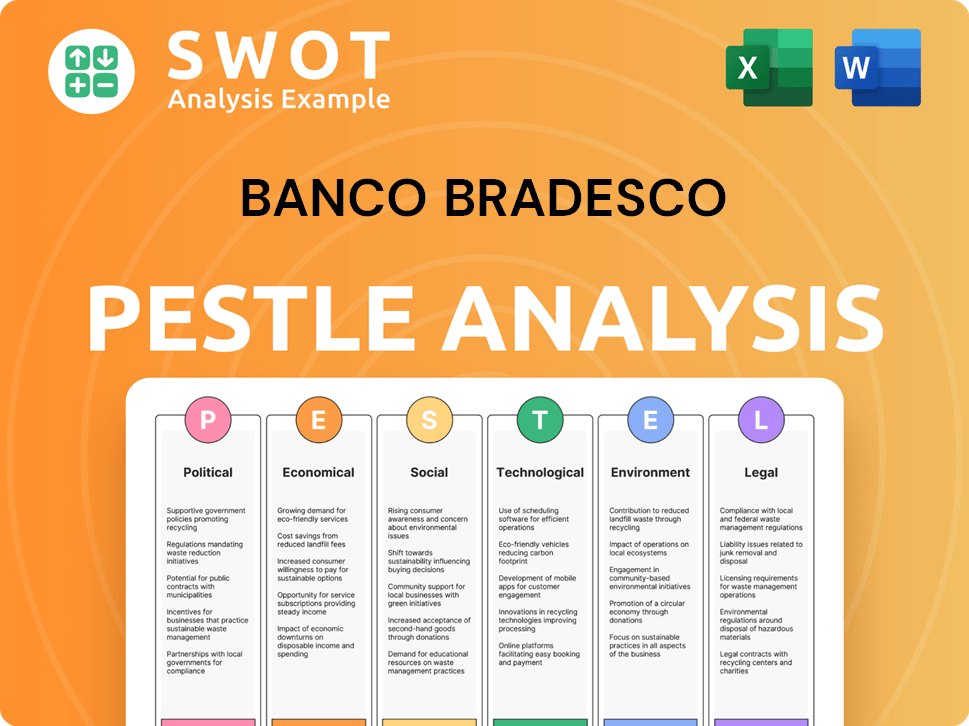
Who Sits on Banco Bradesco’s Board?
As of late 2024 and early 2025, the Board of Directors of Banco Bradesco comprises 11 members. These directors serve two-year terms and are eligible for re-election. A noteworthy aspect of the board is that four members are classified as independent, meeting the criteria set by Brazilian Corporate Law. The remaining members are affiliated with Fundação Bradesco, which may influence their alignment with the interests of all Bradesco shareholders. Luiz Carlos Trabuco Cappi chairs the board, while Marcelo de Araujo Noronha has served as the Chief Executive Officer (CEO) since November 2023.
Other key figures on the board include Alexandre da Silva Glüher (Vice Chairman), Denise Aguiar Alvarez, Maurício Machado de Minas, Rubens Aguiar Alvarez, Octavio de Lazari Junior, Rogério Pedro Câmara, Samuel Monteiro dos Santos Junior, Walter Luis Bernardes Albertoni, Paulo Roberto Simões da Cunha, and Denise Pauli Pavarina. Samuel Monteiro dos Santos Junior, Walter Luis Bernardes Albertoni, Paulo Roberto Simões da Cunha, and Denise Pauli Pavarina are specifically identified as independent members. In September 2024, Rogério Pedro Câmara joined the Board of Directors, replacing Milton Matsumoto. The board's composition and the presence of independent members are crucial for the bank's governance and alignment with shareholder interests.
| Board Member | Position | Independent |
|---|---|---|
| Luiz Carlos Trabuco Cappi | Chairman | No |
| Marcelo de Araujo Noronha | CEO | No |
| Alexandre da Silva Glüher | Vice Chairman | No |
| Denise Aguiar Alvarez | Director | No |
| Maurício Machado de Minas | Director | No |
| Rubens Aguiar Alvarez | Director | No |
| Octavio de Lazari Junior | Director | No |
| Rogério Pedro Câmara | Director | No |
| Samuel Monteiro dos Santos Junior | Director | Yes |
| Walter Luis Bernardes Albertoni | Director | Yes |
| Paulo Roberto Simões da Cunha | Director | Yes |
| Denise Pauli Pavarina | Director | Yes |
Banco Bradesco's ownership structure is centered around its publicly-held status, with shares traded on the Stock Exchange. This structure allows any investor holding Bradesco stock to be a proportional owner. However, Fundação Bradesco holds significant direct and indirect ownership, thereby maintaining primary voting control. Decisions concerning acquisitions, divestments, financing, and other transactions are often influenced by Fundação Bradesco and the Board of Directors. Amendments to the bylaws, approved in March 2024, grant the Board of Directors the authority to decide on transactions with related parties and provide flexibility in the rules for Senior Leadership candidates. These changes support less hierarchical structures, faster decision-making, and increased autonomy for leaders. To learn more about the bank's strategic direction, consider reading about the Growth Strategy of Banco Bradesco.
Understanding the ownership of Banco Bradesco is crucial for investors and stakeholders. The bank's structure involves a mix of public shareholders and significant control by Fundação Bradesco.
- Fundação Bradesco is the Bradesco parent company, holding major voting rights.
- The Board of Directors includes independent members to ensure balanced governance.
- Changes in bylaws aim for efficient decision-making and leadership autonomy.
- Knowing who owns Bradesco is key to understanding its strategic direction.
Banco Bradesco Business Model Canvas
- Complete 9-Block Business Model Canvas
- Effortlessly Communicate Your Business Strategy
- Investor-Ready BMC Format
- 100% Editable and Customizable
- Clear and Structured Layout
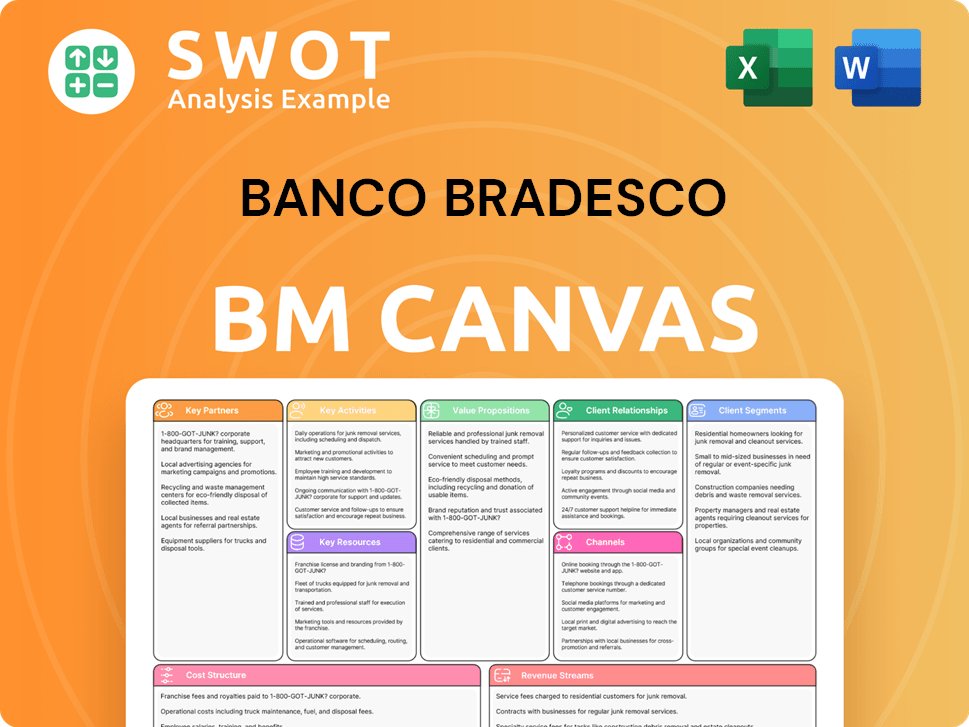
What Recent Changes Have Shaped Banco Bradesco’s Ownership Landscape?
Over the past few years, the ownership structure of Banco Bradesco has remained relatively stable, with a focus on internal strategic shifts rather than significant external changes. In November 2023, Marcelo de Araújo Noronha took over as CEO, succeeding Octavio de Lazari Junior. This leadership transition aligns with the bank's broader strategic plan announced in February 2024, which aims to streamline operations and management for increased autonomy and agility. The bank is actively working on operational efficiency and digital transformation to stay competitive and boost profitability.
Industry trends indicate a rise in institutional ownership and strategic moves to compete with agile fintech companies. Banco Bradesco's initiatives for 2025 include improving return on equity, which faced pressure in 2023-2024, enhancing digital channel efficiency, and managing credit quality. The bank continues to invest in technology and digital platforms like Next and Bitz. These moves highlight a shift towards a customer-focused, data-driven approach. Understanding who owns Bradesco is crucial for investors and stakeholders alike.
| Metric | Data | Year |
|---|---|---|
| Return on Equity (ROE) | Under Pressure | 2023-2024 |
| Digital Channel Efficiency | Focus on Enhancement | 2025 |
| Credit Quality Management | Ongoing Focus | 2025 |
The ownership of Banco Bradesco is primarily influenced by Fundação Bradesco, which holds a controlling interest. This structure ensures alignment with the foundation's long-term goals. While there haven't been large-scale share buybacks or significant secondary offerings in 2024-2025, the company's internal transformation and digital growth strategies are key. Public statements and analyst reports emphasize the ongoing transformation to become a 'different bank' by 2026, focusing on improved efficiency and digital engagement. For more insights, check out the Marketing Strategy of Banco Bradesco.
The ownership structure is largely influenced by Fundação Bradesco, which holds a controlling interest. This ensures alignment with long-term objectives.
Banco Bradesco is heavily investing in digital platforms like Next and Bitz to enhance customer experience and operational efficiency.
The bank is focused on improving return on equity, enhancing digital channel efficiency, and managing credit quality.
Marcelo de Araújo Noronha became CEO in November 2023, signaling a shift in strategic direction and operational focus.
Banco Bradesco Porter's Five Forces Analysis
- Covers All 5 Competitive Forces in Detail
- Structured for Consultants, Students, and Founders
- 100% Editable in Microsoft Word & Excel
- Instant Digital Download – Use Immediately
- Compatible with Mac & PC – Fully Unlocked
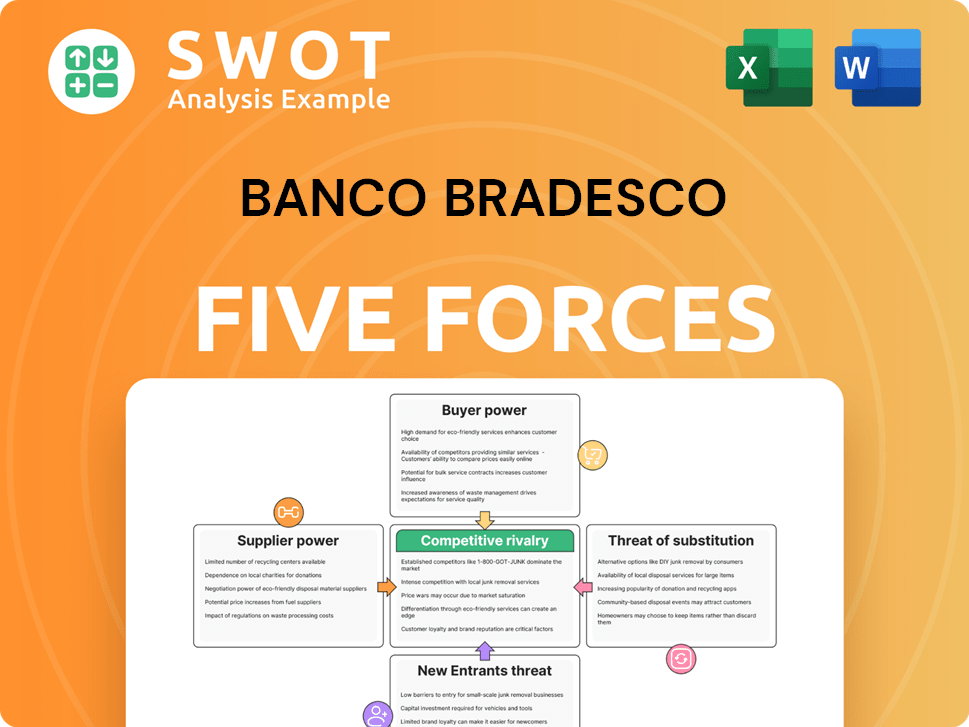
Related Blogs
- What are Mission Vision & Core Values of Banco Bradesco Company?
- What is Competitive Landscape of Banco Bradesco Company?
- What is Growth Strategy and Future Prospects of Banco Bradesco Company?
- How Does Banco Bradesco Company Work?
- What is Sales and Marketing Strategy of Banco Bradesco Company?
- What is Brief History of Banco Bradesco Company?
- What is Customer Demographics and Target Market of Banco Bradesco Company?
Disclaimer
All information, articles, and product details provided on this website are for general informational and educational purposes only. We do not claim any ownership over, nor do we intend to infringe upon, any trademarks, copyrights, logos, brand names, or other intellectual property mentioned or depicted on this site. Such intellectual property remains the property of its respective owners, and any references here are made solely for identification or informational purposes, without implying any affiliation, endorsement, or partnership.
We make no representations or warranties, express or implied, regarding the accuracy, completeness, or suitability of any content or products presented. Nothing on this website should be construed as legal, tax, investment, financial, medical, or other professional advice. In addition, no part of this site—including articles or product references—constitutes a solicitation, recommendation, endorsement, advertisement, or offer to buy or sell any securities, franchises, or other financial instruments, particularly in jurisdictions where such activity would be unlawful.
All content is of a general nature and may not address the specific circumstances of any individual or entity. It is not a substitute for professional advice or services. Any actions you take based on the information provided here are strictly at your own risk. You accept full responsibility for any decisions or outcomes arising from your use of this website and agree to release us from any liability in connection with your use of, or reliance upon, the content or products found herein.